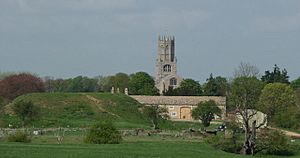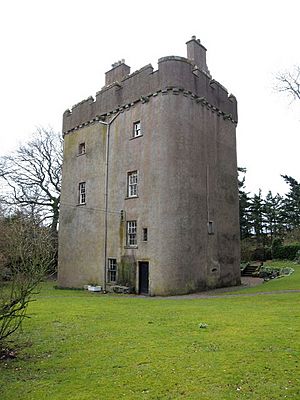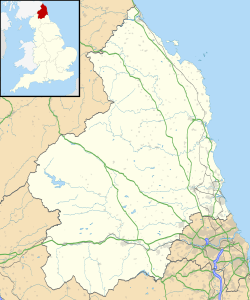English invasion of Scotland (1482) facts for kids
Quick facts for kids English invasion of Scotland |
|||||||
|---|---|---|---|---|---|---|---|
| Part of the Anglo-Scottish Wars | |||||||
|
|||||||
| Belligerents | |||||||
| Commanders and leaders | |||||||
| Strength | |||||||
| 500 | 20,000 | ||||||
| Casualties and losses | |||||||
| Unknown | Unknown | ||||||
| Berwick Castle | |
|---|---|
| Northumberland, England, UK | |
|
Location in Northumberland
|
|
| Coordinates | 55°46′30″N 2°00′47″W / 55.775°N 2.013°W |
| Grid reference | NT992535 |
In July 1482, an English army marched into Scotland during the Anglo-Scottish Wars. They captured the town of Berwick-upon-Tweed and its castle. The English army even briefly took over Edinburgh, Scotland's capital.
These events happened after a special agreement called the Treaty of Fotheringhay. This treaty was signed on June 11, 1482. In it, Alexander Stewart, Duke of Albany, who was the brother of the Scottish King James III of Scotland, said he wanted to be King of Scotland. He also promised to be loyal to Edward IV of England.
Edward IV's brother, Richard, Duke of Gloucester, led the invasion. But they couldn't make Albany the new king. However, Berwick Castle surrendered on August 24, and Berwick has been part of England ever since. The English army left Edinburgh after the Scots promised to pay back money for a royal marriage that didn't happen. This money was a dowry for Princess Cecily of England, who was supposed to marry the Scottish Prince.
Contents
The Fotheringhay Agreement
King Edward IV of England was unhappy because a treaty he made with King James III of Scotland in 1474 didn't work out. James III had promised that his son, Prince James, would marry Edward's daughter, Cecily of York.
This engagement was set up in October 1474. A peace agreement was supposed to last for 45 years, until 1519. Princess Cecily's dowry, which was a payment made to the groom's family, was 20,000 marks. Edward's servants were supposed to deliver parts of this payment every year in Edinburgh.
However, fighting started again along the border in 1480. This might have been because Scotland had a long-standing alliance with France, called the Auld Alliance. There were raids on both sides of the border. By October, James III asked the King of France for guns and soldiers to help defend Scotland.
England also prepared for war. Ships were made ready for battle in February 1481. English ships raided the River Forth, attacking Blackness Castle and bothering other ships. There were also three Scottish army raids into England that year. Edward IV started to travel north to lead an invasion, but he only got as far as Nottingham.
In May 1482, James III's brother, Alexander, Duke of Albany, arrived in England from France. He landed at Southampton. Edward IV saw this as a chance to invade Scotland. He quickly hired Albany's ship and called for soldiers to support Albany as the "king of Scotland."
Edward IV, Albany, and Richard, Duke of Gloucester, signed a formal treaty. This happened at Fotheringhay Castle near Peterborough. This castle is famous because Mary, Queen of Scots was later held and executed there.
According to the treaty, if Alexander became King of Scotland, he would give Berwick upon Tweed to Edward IV. He would also give up Lochmaben Castle and other lands in southern Scotland. Albany also promised to be loyal to Edward IV and end Scotland's alliance with France. He even said he would marry Cecily of York if he could end his current marriage. Albany had just married Anne de la Tour in January. On June 11, Albany signed the treaty as "Alexander R.," meaning Alexander, King.
The Invasion Begins
Edward IV had gathered a large army of 20,000 soldiers to invade Scotland. They planned to attack by both sea and land. On June 12, Richard, Duke of Gloucester, was made the commander of this army.
One of Gloucester's officers, Francis Lovell, wrote that he couldn't travel south because he had to join Gloucester's army. The army was well-supplied. They had 2,000 bundles of arrows and weapons brought from Newcastle upon Tyne. These supplies were carried by 120 cart horses.
Gloucester and Albany quickly recaptured Berwick town. Berwick had been controlled by the Scots for the past 20 years. It was given to James III by the English King Henry VI of England and his wife Margaret of Anjou. The Scottish leaders in Berwick, David Lindsay, Earl of Crawford and Andrew, Lord Gray, surrendered after talks. However, Berwick Castle still held out.

Lauder Bridge Incident
After taking Berwick, the English army moved west. They split into two groups. The Earl of Northumberland stayed near the Scottish border. He captured castles, burned farms, and raided several towns like Kirk Yetholm and Jedburgh.
Richard, Duke of Gloucester, also moved west. He was supported by James, Earl of Douglas. Near Duns, Gloucester turned north-west towards Edinburgh.
Meanwhile, the Scottish army of King James III didn't get further south than Lauder Bridge. This was west of Gloucester's path. At Lauder, something like a mutiny happened. It involved Archibald, Earl of Angus. The exact details are not clear. But later stories say that some of the king's close friends were hanged from the bridge. These friends included an architect, a merchant, a tailor, and a composer.
King James III was brought back to Edinburgh on July 22. At this point, there were three main groups in Scotland. There was Albany's group, the loyal supporters of the King, and the soldiers who mutinied at Lauder. The Queen, who was at Stirling with Prince James, might also have had her own influence.

Gloucester in Edinburgh
At the start of August, Richard's army entered Edinburgh. But he couldn't make Albany the new King. James III was safe inside Edinburgh Castle. He was held there by the lords who had mutinied at Lauder. However, James had secretly made a deal with the castle's keeper, Lord Darnley, to ensure his safety.
Richard's army wasn't ready for this unexpected situation. They didn't have the supplies to attack Edinburgh Castle. As the details of the Fotheringhay treaty became known, Albany lost support from the Scots. Many Scots didn't want him to be king if it meant giving up land to England.
Eventually, Albany and the lords holding the castle made peace. On August 2, Albany and Gloucester signed an agreement with several Scottish nobles and church leaders. This agreement promised Albany a pardon and gave him back his old titles.
The English army made a truce on August 4. They left Edinburgh after the town promised to pay back the dowry money for Princess Cecily. This money had been paid because James III had promised his son would marry Cecily. Albany was left to take control of Edinburgh Castle. For a time, he held his brother, King James, captive.
Gloucester left 1,700 men to attack Berwick Castle on August 11. The castle was captured after a siege that lasted two weeks.
Edward IV wrote to Pope Sixtus IV on August 25. He described the campaign in Scotland. Edward said that Richard had spared the people of Edinburgh. He also said Albany was given back his lands because of the English army's power. Edward explained that taking Berwick was the main advantage he gained. He wrote that Berwick Castle was taken on the army's return, with "slaughter and bloodshed." This letter was written before Edward could have known the castle had surrendered peacefully on August 24.
Edinburgh Castle Siege
After Gloucester left, Albany tried to find more supporters. He may have talked with the Queen, Margaret of Denmark, at Stirling Castle. Then, he laid siege to Edinburgh Castle. King James III came out of the castle on September 29. But Lord Darnley, who had joined James's side, kept defending the castle until October 7.
Historian Norman Macdougall believes James III left the castle after Albany made a deal with some of the rebels from Lauder. James wrote an official letter on October 19 to Lord Darnley. In it, he confirmed that he was brought from Lauder and held in the castle against his will. The letter cleared the castle guards of any blame. James III wrote that Darnley had made a deal to keep him safe. He also said Darnley held the castle against Albany's siege on James's orders.
Aftermath of the Invasion
For several months, Albany remained powerful in Scotland. On December 11, James III made him "Lieutenant-General of the realm." This meant Albany was in charge of defending the borders from English raids.
When James III got his power back, he rewarded the Provost of Edinburgh, Walter Bertrahame. Bertrahame had promised to repay Cecily's dowry while the King was held in Edinburgh Castle. James gave him a pension of £40 on January 8, 1483. The King also paid bills for making unpopular copper coins and for iron used for cannons. He also arranged to repay money taken from a customs officer at Lauder.
Albany went to Dunbar Castle and renewed his treaty with Edward IV in February. This new treaty was made in Westminster. It involved English and Scottish nobles. This action accidentally made his older brother, King James, stronger at home. The Scottish Parliament declared Albany a traitor in June. This was because he made this new treaty, not for what happened the previous summer. After being exiled, Albany tried to invade Scotland again with the Earl of Douglas. But they were defeated at the Battle of Lochmaben Fair.
Plans were made to repair Berwick Castle and the town in 1483. The master carpenter of Berwick was ordered to build 120 houses in the town. He also had to build rooms and a hall in the castle. In England, the phrase "I was a captain when Barwycke was wonne" became a common saying. It meant someone was very proud of their achievements.
Different Historical Stories
The Scottish history books from the 1500s tell a slightly different story. They all say that the King's unpopular copper coins and his favoritism towards non-noble friends were big reasons for the trouble at Lauder.
Robert Lindsay of Pitscottie, who wrote in the 1570s, misunderstood the Treaty of Fotheringhay. He wrote that Albany rescued his brother after the mutiny at Lauder Bridge. He said Albany sought English help at the King's request. After Gloucester came to Edinburgh and James III was freed, the royal brothers rode together. This might show Albany trying to gain support while James III was still in Edinburgh Castle.
The idea that Albany brought an army to rescue his brother also appears in a short history written by a monk named Adam Abell in the 1530s. Historian Norman Macdougall thought that writers in the 1500s were influenced by later stories that praised the Albany family.
History that showed James III in a bad light and praised Albany might have been popular with the people around James IV and Albany's son, John, Regent Albany. Macdougall calls this the "Albany legend." This legend, along with official records, shaped how these historians wrote in the 1570s.
Other records, like a special document from November 16, 1482, also helped this legend. In this document, James III rewarded the town of Edinburgh. He gave them the right to collect customs duties from Leith. The document said that the people of Edinburgh and Albany had loyally helped free him from Edinburgh Castle.
John Lesley, who knew that Alexander wanted to be king in 1482, wrote that Gloucester took Berwick on his way back to England. He said Sir Patrick Hepburn defended it strongly, and the English had many casualties. An English record also says Berwick Castle was taken with "vast slaughter and bloodshed." This is similar to what Edward IV wrote to the Pope.
George Buchanan wrote that Albany was camped with the English army in August. He said Albany made peace through talks with Scottish nobles and bishops. According to Buchanan, Berwick Castle surrendered on August 26 through negotiations in Edinburgh.
The English writer Raphael Holinshed, who used Lesley's work, believed James III went to Lauder Bridge to meet his brother's invasion. He wrote that Lord Stanley and Sir John Elrington held Berwick town. Meanwhile, Gloucester went to Edinburgh. Holinshed and Lesley also mention an English navy in the Forth River, which other writers don't. Holinshed adds that after making peace, Albany sent an army south to help Lord Hailes at Berwick. He says Patrick Hepburn gave up the castle on August 24. Hepburn knew there was little hope of help because of the disagreements in Scotland.
English Accounts
The English history book by John Stow, first published in 1580, adds more details. Stow says Edward IV invaded Scotland because Albany asked him to. He also says Edward borrowed £5,000 from the City of London. This amount is less than the dowry money James III received.
The army gathered at Alnwick in early July. It was divided into three main groups. The first group was led by the Earl of Northumberland with 6,700 soldiers. Gloucester led the middle group with Albany and 5,800 men. Other lords led smaller groups.
Stow and Richard Grafton called the keeper of Berwick Castle, Patrick Hepburn, "Earl of Bothwell." He actually got that title later, in 1488. Since Hepburn wouldn't give up the castle, 4,000 soldiers were left to besiege it. On the way to Edinburgh, the army burned many towns and castles.
Edward Hall's earlier book, published in 1542, gave the army's battle order. He listed about 40 places Gloucester burned. He also listed places the Earl of Northumberland burned during a separate campaign. Richard Grafton's book, published in 1569, has similar details.
Hall doesn't say much about Lauder. He wrote that James III willingly went into Edinburgh Castle. This matches the detail about Lord Darnley's secret deal. Stow says the Scottish army was at Haddington. He also says Albany made peace with the lords and was made "Lieutenant-General of Scotland."

Hall's book says the army entered Edinburgh without destroying anything, because Albany asked them not to. It also says they made a public announcement for James III in the castle. The Scottish lords and army were at Haddington. After the peace was made, Hall describes an agreement signed on August 3. This agreement was between Albany and Gloucester. Albany promised to keep his treaty with Fotheringhay, even with his new agreement with his brother.
Hall quotes the agreement from August 4 where the city of Edinburgh promised to repay the dowry. Grafton says Albany told Edinburgh to make this promise after Berwick Castle surrendered. Both Hall and Grafton say the Garter Herald King at Arms returned to Edinburgh on October 23 to ask for the payment. This date is almost correct. Edward IV decided to cancel the marriage and get the money back. The Garter herald John Writhe came to Edinburgh on October 26.
Hall and Grafton continue that Albany only let James III out of the Castle after this. But records show James III was released earlier.
Soon after August 4, according to Hall's book, Albany called the army to help Berwick Castle. He told Gloucester it was just a trick. Gloucester said he would defend the soldiers besieging Berwick. However, the Scottish council didn't want to fight. Instead, they drafted a surrender of Berwick Castle by treaty in Edinburgh on August 24. When the document was signed, Berwick Castle was given to Lord Stanley right away.
It's possible the castle fell to Stanley before Albany's talks with the council were finished. Or Edward IV might have expected the castle to be taken by force when he wrote his letter to the Pope.

Hall's 1542 book, which used English historical sources, might be less influenced by the "Albany legend." It shows Albany acting in a tricky way. Yet, Hall ends his account of 1482 by feeling sorry for Albany's eventual fate. He compares it to the Duke of Clarence. Hall says it was caused by James III's "envy" against his brother, who helped him gain freedom. This seems to go against his own story of the invasion.
Stow says that when Berwick Castle was given to Stanley, Sir Thomas Molyneux was knighted there. Edward Hall mentioned "Hooton" and "Heton Hall" as burned places. These might be Hatton-Field, where Gloucester is said to have knighted Sir Ralph Assheton and 26 others on August 22. This was around the time Berwick Castle surrendered. The Earl of Northumberland is said to have knighted 18 men at "Sefford" (Cessford) during an earlier campaign, or at the same time. A total of 70 knights were made on August 24. This seems to mark the end of the fighting. The knighting on August 22 might have led to Edward's letter to the Pope.
Stow concludes by saying the Duke of Gloucester returned to Sheriff Hutton. Edward IV rewarded the Mayor of London, William "Harriot," and some city leaders with a feast and hunting. This feast appears in other books about Edward IV as an example of his generosity. It's not always linked to the Scottish expedition. Stow's description of a city loan and reward is supported by old documents. Edward IV's Garter King of Arms gave the bond from Edinburgh to William Heryot, Mayor of London, on October 11, 1482. The Garter herald went to Edinburgh and arranged its payment with the city on October 27, 1482.
Images for kids
-
The Trinity Altarpiece shows from right, Margaret of Denmark facing James III with their son James, Duke of Rothesay.
Royal Collection / National Gallery of Scotland



